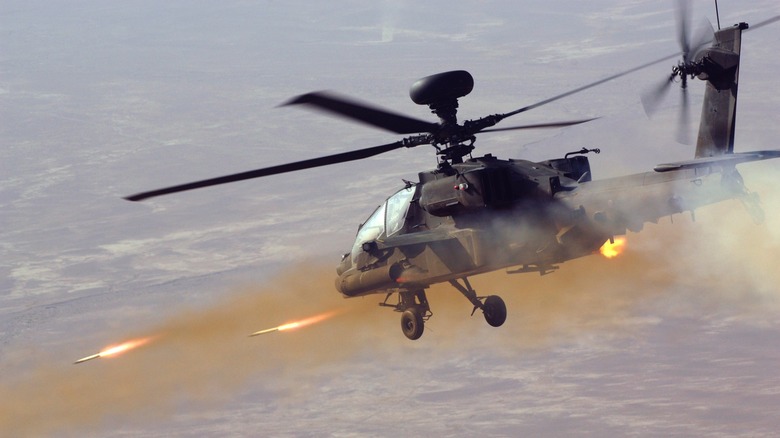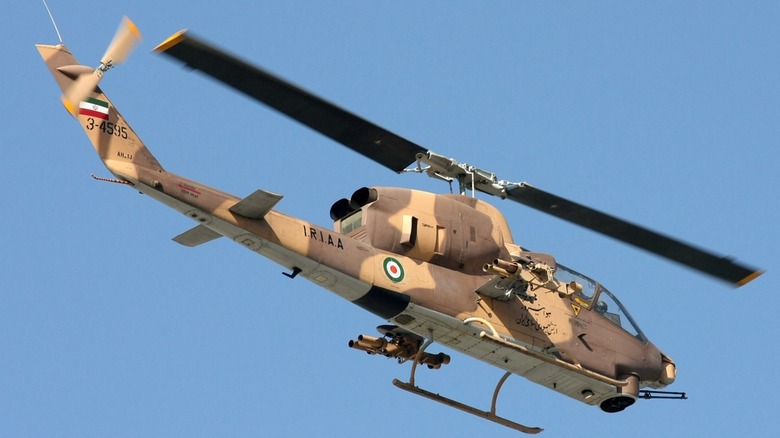Can A Helicopter Take Down A Fighter Jet?
Helicopters are large, complex aircraft that have been used in military operations for almost as long as they've been around. As agile vehicles, helicopters completely changed how troops are inserted and evacuated from hostile locations. Moreover, they've proven themselves time and again to be efficient attack aircraft. For the most part, when a helicopter is labeled as "attack," it means the chopper has the ability to engage targets on the ground. For decades, this has been the case, and helicopters routinely destroy vehicles and other military hardware.
Yet helicopters don't occupy the skies alone, and it's not uncommon for contested airspace to include enemy fighter jets. Believe it or not, many modern military helicopters carry air-to-air missiles, like the AIM-9 Sidewinder, although these are not intended for use against jets. Instead, a chopper's air-to-air missiles are meant for defense against other helicopters. This is because it's incredibly difficult to hit a fast-moving fighter jet from a comparatively slow-moving helicopter.
There are no confirmed documented cases of a helicopter firing its air-to-air missiles at a fighter jet and taking it out of the sky. There are claims of this happening during the long-fought Iran-Iraq War, though these claims are difficult to verify. Regardless, helicopter pilots technically have the capability at their fingertips, and various exercises have proven it's possible.
An exercise in the 1970s delivered surprising results
Before the Iran-Iraq War broke out in 1980, the United States Air Force and U.S. Army conducted a joint exercise that tested the theoretical capability of a helicopter to shoot down a fighter jet. The Joint Countering Attack Helicopter (J-CATCH) was one of the first such efforts. Previous exercises tested a helicopter's anti-tank capabilities, which changed Army doctrine, but using choppers against fighters was a new concept.
J-CATCH was conducted in part as a response to the introduction of the Mil Mi-24 "Hind," which represented a growing Soviet helicopter force. The exercise was conducted in a series of phases, and the third phase tested helicopters against aircraft such as the F-4 Phantom II, A-7 Corsair II, A-10 Thunderbolt II, and the fast-moving F-15 Eagle fighter jet. During the program, these aircraft were engaged by helicopters with such ferocity that they achieved a five-to-one kill ratio using their cannons over the fixed-wing aircraft.
The AH-1 Cobra was particularly capable of taking down fixed-wing aircraft, as explained by former U.S. Army Cobra pilot Nick Lappos: "A well-equipped attack helicopter flown by a trained crew will defeat most fighter airplanes in 1v1 air combat, should the fighter be foolish enough to drop down to try and engage." In many of their engagements during J-CATCH, the Air Force pilots didn't even know they were "shot down" until it was too late. The exercise proved that helicopters were not only capable of shooting down fighter jets, but that they were also incredibly adept at doing so.
The unconfirmed claims of the Iran-Iraq War
While there have been no confirmed instances of a helicopter downing a fighter jet, there are stories of five such occurrences that have popped up in the 20th century. In Anthony G. Williams and Emmanuel Gustin's book, "Flying Guns of the Modern Era," they state that the Islamic Republic of Iran Army Aviation (IRIAA) shot down three MiG-21s, one Su-20, and one MiG-23 in separate engagements during the Iran-Iraq War. According to Williams and Gustin, all of these attacks were performed by the Bell AH-1J SuperCobra attack helicopter, which was primarily used domestically by the U.S. Marine Corps.
The downing of the MiG-23, they wrote, was a shared victory between a AH-1J and another unspecified aircraft. In each case, the weapon used to shoot down the fighter was the helicopter's 20mm M197 electric cannon. This claim is repeated on some other unofficial websites and forums. However, there's no confirmation beyond the book, which doesn't cite a direct source for the information.
As such, these claims should be treated with a grain of salt, and there remains no confirmed accounting of a helicopter shooting down a fighter jet. Still, they are theoretically capable of doing so with the element of surprise and a well-fired air-to-air missile or pull of the cannon's trigger. Ultimately, helicopters are best used for ground offensive strikes, while they've also been successful in shooting down other choppers.


